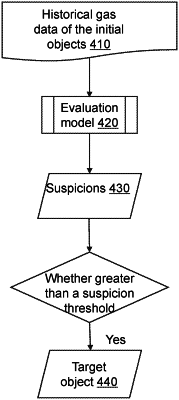| CPC H04Q 9/02 (2013.01) [H04L 67/12 (2013.01); H04Q 2209/60 (2013.01)] | 16 Claims |

|
1. A method for gas usage monitoring and warning based on smart gas, which is performed by a smart gas safety management platform of an Internet of Things system for gas usage monitoring and warning based on smart gas, comprising:
obtaining gas usage data from at least one gas device through a smart gas household device sensing network platform of the Internet of Things system and sending the gas usage data to the smart gas safety management platform, wherein the at least one gas device is configured in a smart gas household device object platform of the Internet of Things system;
based on the gas usage data, determining a gas monitoring object from the at least one gas device;
determining initial objects based on the gas monitoring object and a gas usage threshold, the gas usage threshold including a usage length threshold and a usage volume threshold;
processing historical gas data of the initial objects by using an evaluation model to determine suspicions of the initial objects, wherein the evaluation model is a machine learning model and obtained through joint training;
determining a target object based on the suspicions; and
sending gas usage safety warning information to a gas user corresponding to the target object;
wherein the determining the gas usage threshold includes:
obtaining environmental data, wherein the environmental data includes seasonal information, time-point information, and area information;
constructing a gas environment vector based on the environmental data;
constructing a reference database, wherein the reference database includes a reference vector and gas usage data corresponding to the reference vector, the reference vector being constructed based on historical environmental data;
determining at least one target reference vector by using vector matching based on the gas environment vector and the reference database; and
determining the gas usage threshold based on gas usage data corresponding to the at least one target reference vector.
|